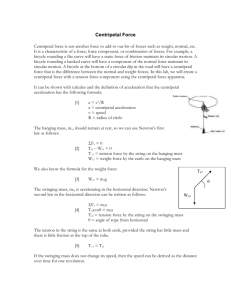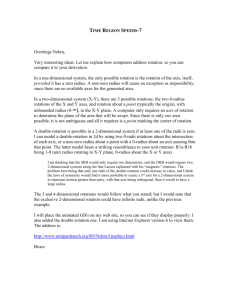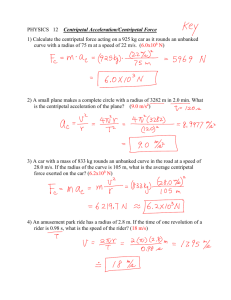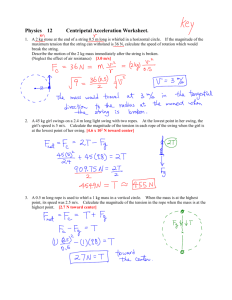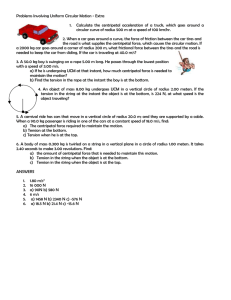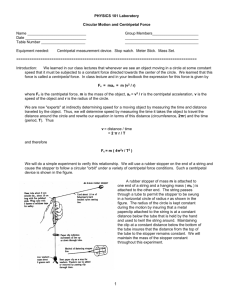Lab- Circular Motion Design
advertisement
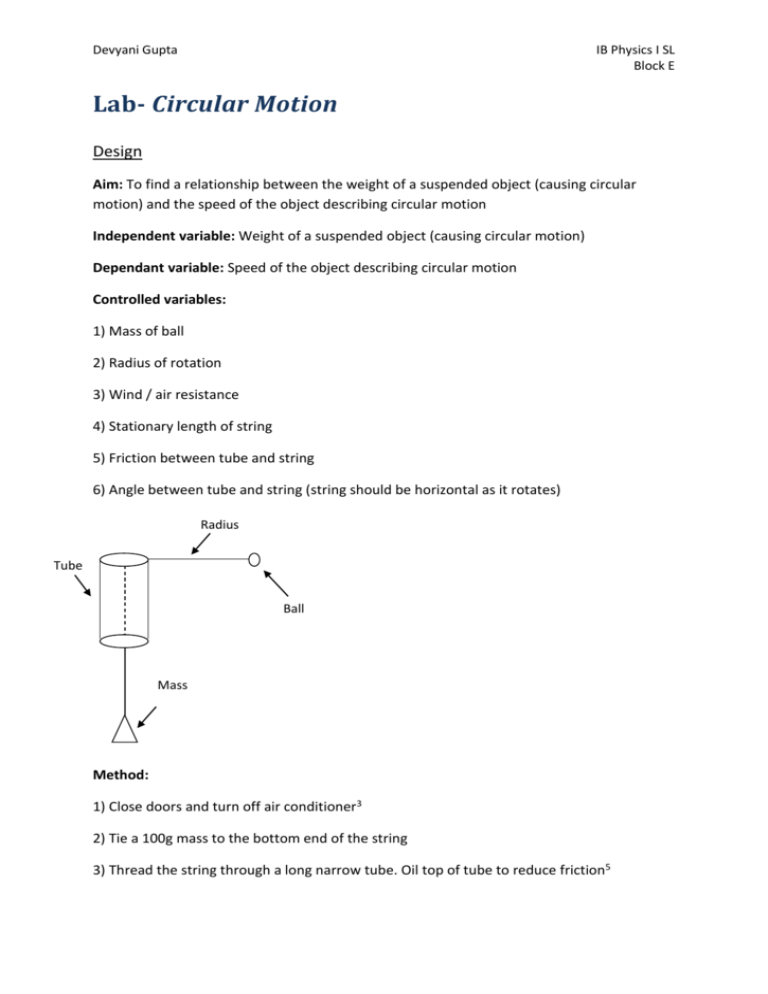
Devyani Gupta IB Physics I SL Block E Lab- Circular Motion Design Aim: To find a relationship between the weight of a suspended object (causing circular motion) and the speed of the object describing circular motion Independent variable: Weight of a suspended object (causing circular motion) Dependant variable: Speed of the object describing circular motion Controlled variables: 1) Mass of ball 2) Radius of rotation 3) Wind / air resistance 4) Stationary length of string 5) Friction between tube and string 6) Angle between tube and string (string should be horizontal as it rotates) Radius Tube Ball Mass Method: 1) Close doors and turn off air conditioner3 2) Tie a 100g mass to the bottom end of the string 3) Thread the string through a long narrow tube. Oil top of tube to reduce friction5 Devyani Gupta IB Physics I SL Block E 4) Attach the other end to a small steel ball using masking tape 5) Swing the ball around at a constant radius of 17cm by putting a mark on the string at the 17cm mark2. (Have an observer watch from side-on to ensure all rotations are on horizontal plane.)6 6) Count the number of rotations in 10s. Perform three times 7) Measure string at end of trial to make sure it hasn’t stretched 4 8) Repeat steps 1-5 for 200g, 300g, 400g masses *Note: 100g chosen as smallest mass. Anything smaller would not be able to provide enough centripetal force. Anything over 400g at high speed rotation becomes dangerous. *Note: be sure to use the same ball for each trial1 Raw Data Mass m/kg 0.1 0.2 Trial 1 29 35 Rotations in 10 seconds R/# ∆R = ±2 Trial 2 30 34 0.3 47 39 Radius r/cm ∆r = ±3 cm Trial 3 29 35 17 17 43 17 Justification of Uncertainty: Mass- The uncertainty is negligible because it's reasonable to trust the manufacturer's stated values. Rotations- There is an uncertainty of 2 rotations as it is reasonable as it's difficult to count the fast moving object. Radius- There is an uncertainty of 3 cm as it is difficult to maintain a constant radius during spinning. Observations The mass did not stay in a horizontal plane during rotation. Devyani Gupta IB Physics I SL Block E Processed data Mass Weight m/g W/N 0.1 0.2 0.3 Average rotations in 10 seconds R/# 0.98 1.96 2.94 29 ± 1 35 ± 1 43 ± 4 Time taken for 1 Rotation t/s Speed v/ms-1 Speed² v²/(ms-1)2 .34 ± 0.02 .29 ± 0.02 .24 ± 0.03 3.14 ± 0.01 3.68 ± 0.01 4.45 ± 0.02 9.86 ± 0.02 13.57 ± 0.02 19.80 ± 0.04 Sample calculation (Using mass of 100 grams): Weight: 𝑊 = 𝑚𝑔 = 100(9.8) ≈ 980 Take taken for 1 rotation: 𝑡= 10 10 = ≈ 0.34 ± 0.02 𝑠 𝐴𝑣𝑒𝑟𝑎𝑔𝑒 𝑟𝑜𝑡𝑎𝑡𝑖𝑜𝑛𝑠 29 ± 1 Speed: 𝑣= 𝑑 2𝜋𝑟 2𝜋(0.17 ± 0.03) 2𝜋(0.17 ± 0.18%) = = = = 3.14 ± 0.24% 𝑡 𝑡 0.34 ± 0.02 0.34 ± 0.06% = (3.14 ± 0.01) 𝑚𝑠 −1 Velocity2: 𝑣 2 = (3.14 ± 0.01)2 = 9.86 ± 0.02 Devyani Gupta IB Physics I SL Block E Weight vs. Speed2 3.5 3 Line of Best Fit: W = 0.193v² - 0.821 Max. Line: W = 0.246v² - 1.700 Weight/N 2.5 2 Min. Line: W = 0.164v² - 0.474 1.5 1 0.5 0 0 5 10 15 Speed2/(ms-1)2 Equation of Line of Best Fit: 𝑊 = 0.193𝑣 2 − 0.821 Uncertainty of slope: 𝑀𝑎𝑥 𝑠𝑙𝑜𝑝𝑒 − 𝑀𝑖𝑛 𝑠𝑙𝑜𝑝𝑒 0.246 − 0.164 = = 0.041 ≈ 0.04 2 2 Uncertainty of y-intercept (c): 𝑀𝑎𝑥 𝑐 − 𝑀𝑖𝑛 𝑐 −1.700 − (−0.474) = = 0.615 ≈ 0.62 2 2 Final equation: 𝑊 = (0.19 ± 0.04)𝑣 2 + (0.82 ± 0.62) 20 25 Devyani Gupta IB Physics I SL Block E Conclusion Aspect 1: From the graph, it can be seen that there is a linear relationship between weight and speed2, namely, 𝑊 = (0.19 ± 0.04)𝑣 2 + (0.82 ± 0.62). The graph of the equation shows a non-proportional relationship between weight and speed2. However, it should be proportional as at zero speed, there shouldn’t be any centripetal force. The W-intercept of the equation is (0.82 ± 0.62) which means the value lies between 0.2 and 1.4. This suggests that there is a systematic error in the experiment, which has increased the centripetal force, most probably due to friction. The formula for centripetal force equation is 𝐹 = indicating that represents 𝑚 𝑟 𝑚𝑎𝑠𝑠 𝑚𝑣 2 𝑟 and can be written as 𝑊 = 𝑚 𝑟 𝑣2, is the slope of the Weight vs. Speed2 graph. The slope of the line 𝑟𝑎𝑑𝑖𝑢𝑠 . In the centripetal force equation, 𝑚𝑎𝑠𝑠 𝑟𝑎𝑑𝑖𝑢𝑠 is the coefficient of v2. Therefore, 𝑚𝑎𝑠𝑠 𝑜𝑓 𝑟𝑜𝑡𝑎𝑡𝑖𝑛𝑔 𝑜𝑏𝑗𝑒𝑐𝑡 = 𝑠𝑙𝑜𝑝𝑒 × 𝑟𝑎𝑑𝑖𝑢𝑠 = (0.19 ± 0.04) × 0.17 = 0.32 ± 0.06𝑘𝑔. The scatter of plots indicates random errors in the experiment, possibly because of human error in counting the number of rotations. (Aspect 2) Evaluating data a. The data was reasonably consistent which suggests that there were sufficient trials. b. The range of values for the rotation was appropriate. A lower speed would not be able to overcome friction. Extremely high speed would be dangerous. Evaluating materials c. There was friction between the tube and the string. d. The tube was appropriate. e. String is not strong enough to support a more massive object. Evaluating Techniques f. It is difficult to rotate the object at a constant speed therefore the string did not remain in the horizontal plane. g. Radius was not constant throughout the experiment. h. It was difficult to accurately count the number of rotations. Devyani Gupta IB Physics I SL Block E (Aspect 3) (c) Grease the end of the tube to reduce friction so there is less energy lost. More grease Less friction Higher speed More rotation in a given time. Reduced slope of graph (e) Using a steel cable instead of a string would allow for a more massive object to be rotated. (f) A spotter should have been used to make sure that the angle is exact while rotating. It would be useful to use a spinning machine that could rotate at a constant speed. (g) The machine would ensure a constant radius. (h) A video could be taken and then could be analyzed for an accurate count. To obtain a more accurate value for Centripetal force, we could use a more accurate timer:


